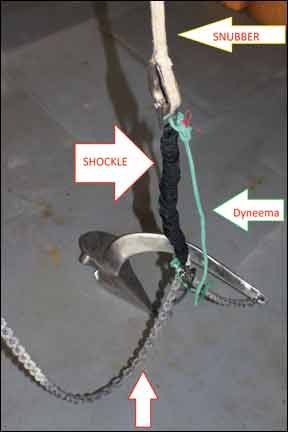The string of anchor tests weve carried out in the last year (PS, May 2012, February 2013, April 2013, and May 2013) presented a good opportunity for us to also test an anchor accessory: the Shockles anchor snubber. Makers claim it helps your anchor stay set by reducing the constant shock loads during strong winds or in rough seas. We did some real-world testing aboard a 6-ton Lightwave 38 catamaran in a range of conditions and anchorages, and we also bench-tested the snubber, using a load cell and chain winch.

PS has tested several commercial anchor-chain snubbers (PS, June 2007, July 2008, and March 2004), and do-it-yourself systems abound. The homemade snubber setup usually used on our test boat is a pair of 45-foot lengths of half-inch braided nylon (cost is about $80). Each nylon snubber attaches to stern cleats on each transom, runs through the stanchion bases to the bow, then through turning blocks on each bow, and terminates at a common chain hook.
Half-inch, double-braided nylon has a tensile strength of 5,000 to 6,000 pounds and will stretch about 25 percent prior to failure, offering about 10 feet of stretch. The Lightwave, if subject to a 30-knot wind-at about a 7:1 scope with all quarter-inch chain rode in 10 feet of water-will have loads around 600 pounds imposed on it. The nylon snubbers will stretch only about 13 inches under that load-well within the nylons capacity.

Sea Trials
The $60 Shockles snubber appeared well made and robust. The 20-inch snubber comprises a piece of elastic polymer attached to nylon webbing at each end attached to 316 stainless shackles with captive pins. The Shockles instructions are quite precise about the stretch allowed (to accommodate chain slack): 30 to 32 inches preferred, with a maximum of 37 inches. A nylon tape keeps the Shockles from over-stretching, and the whole is contained in a protective nylon sleeve.
The first problem testers encountered was how to attach the Shockles to the chain. The company website offers helpful how-to videos, but we found the methods tough to carry out on a bouncing deck. To transfer the load from the anchor chain to the Shockles when you attach the snubber, you have to create slack in the chain. To create the slack, we used a length of double-braid to tie one end of the snubber to the bow. We then attached the Shockles to the chain using a chain hook. To ensure that the Shockles would not stretch beyond the makers recommended maximum, we tied the Shockless two ends together with a 37-inch length of Dyneema.
With the Shockles set up, we were ready to put it to the test. Given that it is rated to 2,000 pounds, testers were surprised when the Shockles stretched to its limit very easily in our 30-knot, 600-pound snatch load situation. In fact, the Shockles stretched to its limit in as little as 15 knots of wind.
With the Shockless limited load capacity in field tests, we decided that rather than use it as the sole snubbing device, we would use it in conjunction with our existing nylon snubber setup for added shock absorption. Testers attached the Shockles to the anchor chain and to the end of the nylon snubbers. Even when the Shockles stretched to its max, we could rely on the strength and elasticity of the nylon.
Bench Test
To figure out what was going on, we took the Shockles to the lab. At the 37-inch maximum set by the manufacturer, our Shockles test snubber held about 110 pounds. Re-testing it confirmed that the 110 pounds was accurate. A 110-pound load is pretty insignificant in an anchoring situation.
Testers stretched the Shockles to 42 inches, and the load increased to just over 600 pounds (a more realistic anchoring load); beyond 42 inches, we would possibly destroy the protective outer sleeve. We contacted the manufacturer about our findings, and they stood by their recommended usage of the Shockles within the 37 inches (preferably 30 to 32 inches), or 110-pound maximum load.
Conclusion
Though well-made, the Shockles snubbers stretch to the max easily and have limited load-handling ability. Well stick with our braided nylon snubber system, using the Shockles on occasion for added shock absorption.







































